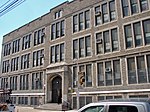Stephen A. Douglas High School
2013 disestablishments in PennsylvaniaEducational institutions disestablished in 2013High schools in PhiladelphiaPennsylvania school stubsPhiladelphia stubs ... and 2 more
Public high schools in PennsylvaniaSchool District of Philadelphia
The Stephen A. Douglas High School was a district-run high school servicing the Fishtown, Port Richmond and Kensington areas of Philadelphia. The school was closed in 2013 as part of Philadelphia's shutdown of 23 district-run schools. Displaced students were enrolled in Penn Treaty, Kensington International Business High School, Kensington Health Sciences Academy, Kensington Urban Education Academy.
Excerpt from the Wikipedia article Stephen A. Douglas High School (License: CC BY-SA 3.0, Authors).Stephen A. Douglas High School
East Huntingdon Street, Philadelphia
Geographical coordinates (GPS) Address Nearby Places Show on map
Geographical coordinates (GPS)
| Latitude | Longitude |
|---|---|
| N 39.9764 ° | E -75.1169 ° |
Address
East Huntingdon Street 2700
19125 Philadelphia
Pennsylvania, United States
Open on Google Maps





